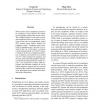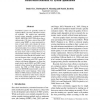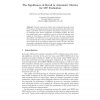ACL
2012
12 years 1 months ago
2012
SMT has been used in paraphrase generation by translating a source sentence into another (pivot) language and then back into the source. The resulting sentences can be used as can...
ACL
2012
12 years 1 months ago
2012
Unsupervised word representations are very useful in NLP tasks both as inputs to learning algorithms and as extra word features in NLP systems. However, most of these models are b...
WSDM
2012
ACM
12 years 7 months ago
2012
ACM
This paper uncovers a new phenomenon in web search that we call domain bias — a user’s propensity to believe that a page is more relevant just because it comes from a particul...
FLAIRS
2011
13 years 2 months ago
2011
This study presents an evaluation of WordNet-based semantic similarity and relatedness measures in tasks focused on concept similarity. Assuming similarity as distinct from relate...
ACL
2011
13 years 3 months ago
2011
A lack of standard datasets and evaluation metrics has prevented the field of paraphrasing from making the kind of rapid progress enjoyed by the machine translation community ove...
NAACL
2010
13 years 9 months ago
2010
Translation systems are generally trained to optimize BLEU, but many alternative metrics are available. We explore how optimizing toward various automatic evaluation metrics (BLEU...
EMNLP
2010
13 years 9 months ago
2010
We present the first evaluation of the utility of automatic evaluation metrics on surface realizations of Penn Treebank data. Using outputs of the OpenCCG and XLE realizers, along...
NAACL
2007
14 years 26 days ago
2007
We propose three new features for MT evaluation: source-sentence constrained n-gram precision, source-sentence reordering metrics, and discriminative unigram precision, as well as...
ACL
2007
14 years 27 days ago
2007
Recent studies suggest that machine learning can be applied to develop good automatic evaluation metrics for machine translated sentences. This paper further analyzes aspects of l...
AMTA
2004
Springer
14 years 3 months ago
2004
Springer
Recent research has shown that a balanced harmonic mean (F1 measure) of unigram precision and recall outperforms the widely used BLEU and NIST metrics for Machine Translation evalu...



